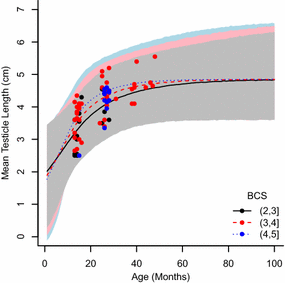Testicular length as an indicator of the onset of sperm production in alpacas under Swedish conditions
- PMID: 26829925
- PMCID: PMC4736141
- DOI: 10.1186/s13028-016-0191-x
Testicular length as an indicator of the onset of sperm production in alpacas under Swedish conditions
Abstract
Background: The popularity of alpacas (Vicugna pacos) is increasing in Sweden as well as in other countries; however, knowledge about optimal management practices under Swedish conditions is still limited. The wide age range reported when the onset of puberty can occur, between 1 and 3 years of age, makes management decisions difficult and may be influenced by the conditions under which the alpacas are kept. The aim of this study was to find out when Swedish alpacas can be expected to start producing sperm, by using testicular length and body condition score as a more precise indirect indicator than age.
Results: This study suggests that animals with a testicular length ≥3.8 cm would be producing sperm; however, if it is crucial to know that there is no sperm production for management purposes, the threshold level for testicular length used to differentiate between sperm-producing and non-sperm producing animals should be ≤1.6 cm instead. If only one variable is considered, testicular length appears to better than age alone to predict sperm production. Body condition score together with testicular length explains the individual onset of puberty and better guide management recommendations.
Conclusions: Using a combination of these parameters (testicular length, body condition score and age) as a tool for decision making for alpaca husbandry under Swedish conditions is suggested.
Figures




References
-
- de Verdier K, Bornstein S. Alpackor i Sverige—en ny utmaning (in Swedish). (Alpacas in Sweden– a new challenge). Svensk Veterinärtidning. Swed Vet J. 2010;1:19–23.
-
- Björklund C. Diseases and causes of death among camelids in Sweden: a retrospective study of necropsy cases 2001–2013. Department of Clinical Sciences, Swedish University of Agricultural Sciences Degree project in Veterinary Medicine. 2014.
-
- Fernandez-Baca S. La alpaca: Reproducción y crianza (in Spanish). (Reproduction and breeding). Centro de Investigación Instituto Veterinario de Investigaciones Tropicales y de Altura (IVITA). Veterinary Research Center for research in tropical and high-altitude areas). Lima, Peru; 1971. 23-27.
Publication types
MeSH terms
LinkOut - more resources
Full Text Sources
Other Literature Sources
Medical

